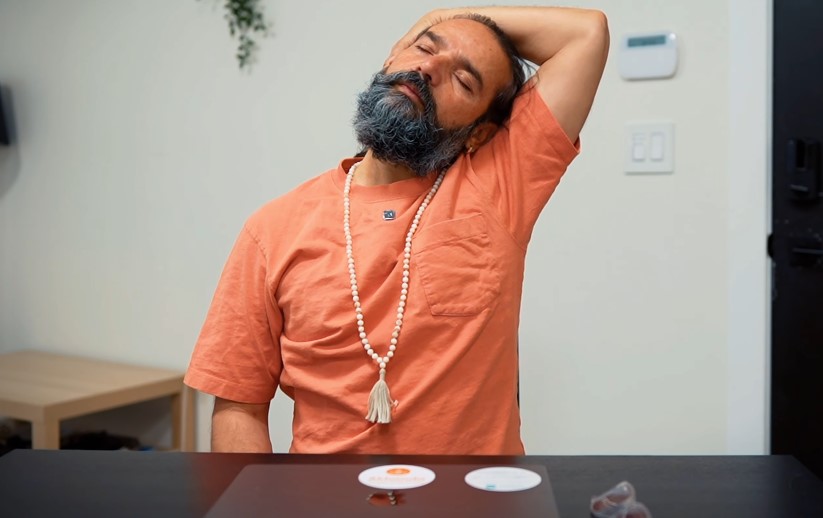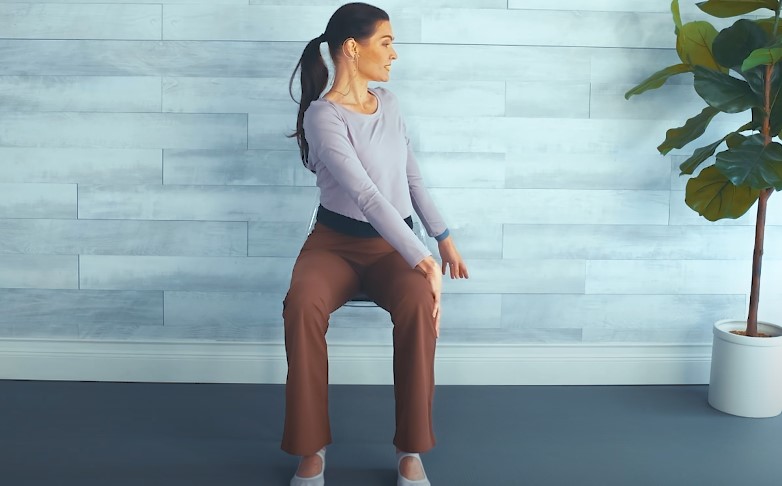In today’s work culture, sitting for long hours has become almost unavoidable. Whether you’re pounding out emails, jumping between Zoom calls, or crunching numbers, that desk chair turns into a second home pretty quickly.
And with it come the usual suspects: tight shoulders, aching backs, stiff necks (also called “Tech neck“), restless legs. But there’s a practical, no-fuss way to give your body a break – without ever leaving your chair.
Welcome to chair yoga. It’s not a trend or a gimmick. It’s a low-key, high-impact way to stretch, breathe, reset, and feel better – all while staying right where you are. No mat needed. No spandex required. Let’s get into it.
A Quick Look
| Pose Name | Primary Benefit | How to Do It (Short Version) |
| Neck Rolls | Relieves neck and shoulder tension | Drop chin, roll head in a circle, repeat both directions |
| Cat-Cow Stretch | Eases upper back and neck tension | Inhale arch spine, exhale round spine, 3-5 rounds |
| Seated Forward Bend | Stretches spine, shoulders, hamstrings | Interlace fingers behind back, fold over thighs |
| Seated Eagle | Opens shoulders, hips, outer thighs | Cross arms and legs, hold and switch sides |
| Seated Spinal Twist | Loosens spine and lower back | Sit sideways, twist toward back of chair |
| Wrist Stretch | Releases typing strain | Stand, palms on desk facing you, lean back slightly |
| Standing Pigeon | Opens hips, glutes | Shin on desk, bend forward, breathe |
| Seated Mountain Pose | Improves posture, energizes | Sit tall, reach arms overhead |
| Shoulder Frames | Encourages shoulder mobility | Goalpost arms, inhale lift, exhale lower |
| Energy Balancing | Calms nervous system | One hand across chest, one behind head, slow breath |
| Finishing Seat | Grounds and centers body and mind | Sit quietly, breathe deeply |
Why Chair Yoga Just Works for Office Life

If you sit for work, you’re not alone. A national survey shared by Doctors Hospital reported that the average American is sitting for about 9.5 hours a day.
That’s a long time for the body to stay idle. Muscles tighten. Blood flow slows. Posture slips. Stress climbs. Chair yoga steps in with a simple offer: move a little, feel a lot better.
- Stress relief: A 2012 study published in the Journal of Alternative and Complementary Medicine showed that just 15 minutes of chair yoga helped reduce stress levels, heart rate, and blood pressure.
- Improved posture: Movements that target your core and spine help support better alignment throughout the day.
- Increased flexibility: Sitting tends to shorten the hip flexors and lock up the shoulders. Gentle stretching helps loosen things back up.
- Boosted circulation: Small movements get the blood flowing, which can fight off that mid-afternoon slump.
- Pain relief: A 2023 study in Healthcare found that chair yoga improved physical function in women with knee osteoarthritis – a reminder that small, targeted movement matters.
And here's the kicker: you can do it in slacks, in a cubicle, between emails. No need to schedule an hour or clear a room.
Quick Pose Guide
Here's a set of chair yoga poses that work well in a typical office environment. They're quiet, subtle, and surprisingly effective.
1. Neck Rolls
Loosens up neck and shoulder stiffness from looking at screens.
How to Do It
- Sit upright, feet flat.
- Drop your chin to your chest.
- Gently roll your head to the right, letting your ear approach your shoulder.
- Circle it around the back, then to the left, and complete the circle.
Pro tip: Keep shoulders relaxed. Move slowly to avoid dizziness. 3 to 5 circles each direction is enough.
2. Cat-Cow Stretch
Releases upper back tension, helps you sit taller.
How to Do It
- Place hands on knees or thighs.
- Inhale and arch your back slightly, lifting your chest and gaze upward.
- Exhale, round your spine, and tuck your chin.
Pro tip: Breathe deep, match movement to breath. Do 3 to 5 rounds.
3. Seated Forward Bend
Stretches your spine, hamstrings, and shoulders.
How to Do It
- Scoot your chair back a bit.
- Interlace fingers behind you.
- Straighten arms and fold forward from the hips.
- Rest your chest on your thighs and let your head hang.
4. Seated Eagle Arms and Legs
Opens up hips, outer thighs, and shoulder blades.
How to Do It
- Cross your right leg over your left. Wrap the foot behind the calf if possible.
- Bring arms forward, cross left over right, and press palms together.
- Lift elbows slightly and hold for 3 to 5 breaths.
- Switch sides.
Pro tip: Can't cross the leg fully? Just stack one knee on top of the other and do the arms only.
5. Seated Spinal Twist
Keeps your spine mobile and releases tension from the back.
How to Do It
- Sit sideways on your chair.
- Keep feet flat and twist toward the chair's back.
- Hold the twist with both hands.
- Breathe here for 3 to 5 slow breaths.
- Turn around and repeat on the other side.
Pro tip: Let the twist come from the belly, not just the shoulders.
6. Wrist and Finger Stretch
Eases tight wrists and fingers from typing or texting.
How to Do It
- Stand and place your palms on your desk, fingers pointing toward you.
- Gently lean your weight back to feel the stretch.
- Hold for 3 to 5 breaths.
Pro tip: Shake out your hands afterward to release tension.
7. Standing Pigeon
Opens tight hips and glutes.
How to Do It
- Stand and place your right shin on your desk, foot flexed.
- Hinge at the hips and fold forward over your shin.
- Hold for a few breaths, then switch legs.
Pro tip: Hold onto a chair for balance if needed. Make sure your desk is stable before starting.
Bonus Poses to Round Out Your Routine
These poses, sourced from Yoga Journal and other trusted outlets, give you more ways to reset when the tension builds up.
Seated Mountain Pose
- Sit tall, inhale and reach arms overhead.
- Feel the lift through your spine.
- Hold for 5 deep breaths.
Shoulder Frames
- Lift elbows to goalpost shape.
- Inhale arms up, exhale lower in front.
- Repeat 3 to 5 times.
Energy Balancing
- Left hand to the right side of your chest.
- Right hand behind your head.
- Breathe deeply for 3 to 5 breaths.
Finishing Seat
- Sit still, hands on thighs.
- Close your eyes.
- Just breathe. Let your body soften.
Want a Short Flow You Can Use Daily?

Here's a quick chair yoga sequence from Piedmont Healthcare that fits into your break time:
- Sit upright, feet grounded.
- Inhale, sweep arms overhead.
- Exhale, press arms out to the side.
- Inhale, look up with chest open.
- Exhale, lean forward and rest.
- Inhale, roll back up.
- Close eyes and breathe deeply.
Takes about five minutes. Works like a reset button.
Building Chair Yoga into Your Work Routine
You don't need a big plan. Just a little consistency.
Try This
- Set reminders: A gentle nudge every 90 minutes can help you build the habit.
- Stack your breaks: Combine chair yoga with a walk to refill your water bottle.
- Use transition moments: Before a big meeting, between tasks, or when your eyes need a break.
- Keep it casual: You're not in a studio. Do what feels good. Skip what doesn't.
Even one pose at a time can make a noticeable difference.
Where Chair Yoga Is Already Making Waves

Plenty of organizations are already on board with chair yoga.
- Tech companies like Google have included it in wellness offerings for on-site teams.
- Remote workers use it to add structure and movement into long days at home.
- Travelers sneak in stretches mid-flight or during layovers.
- Senior centers rely on chair yoga for mobility and mental well-being.
Backed by Numbers
- Stress reduction after just 15 minutes of chair yoga, according to a 2012 study.
- Improved function in people with chronic joint pain after a 12-week chair yoga program.
- Posture correction helps address the chronic pain reported by 80% of desk workers.
- Boosted mood and mental clarity even with short, consistent sessions.
The numbers tell a clear story: small shifts in movement and breath add up.
Final Thoughts
Chair yoga isn't flashy. It's not about nailing the perfect pose or sweating through your shirt. It's about making space - right there in the middle of your workday - to care for your body, to reset your mind, to keep going without falling apart.
Try one pose. Maybe two. See how you feel. That's how it starts. And who knows? A few minutes at your desk might be the most important part of your wellness routine this year.

